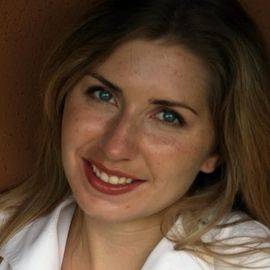Let’s get one thing out of the way: Malia Andrus is a tall drink of talented. But let’s not focus on her obvious height advantage over most humans—augmented, typically by very high heels—and focus on the talented part. It would be enough, for most creative types, to be able to conceive, design, and create costumes for plays and musicals. That’s an amazing gift and one that is indispensible to putting on an entertaining show. But to also be able to dance, to be able to act, and to be able to sing her face off? That’s just greedy.
 Malia Andrus, who has become a very familiar presence to local theatre fans, is someone who can do all of these things, as she has proven time and time again. For CUTC, she slinked and belted as Ulla in The Producers; for Parkland, she brought life to the titular mysterious figure in The Mystery of Edwin Drood; and at the Station Theatre, she has made ’em laugh in Picasso at the Lapin Agile, made ’em cringe in How I Learned to Drive (pictured, right), and made ’em gasp in Rent, Hairspray, and many, many more. In addition to being a regular contributor to plays and musicals at all of our favorite local theatre venues, Ms. Andrus has just completed her first season running the costume shop at Parkland College Theatre and supervising costumes for each Parkland show.
Malia Andrus, who has become a very familiar presence to local theatre fans, is someone who can do all of these things, as she has proven time and time again. For CUTC, she slinked and belted as Ulla in The Producers; for Parkland, she brought life to the titular mysterious figure in The Mystery of Edwin Drood; and at the Station Theatre, she has made ’em laugh in Picasso at the Lapin Agile, made ’em cringe in How I Learned to Drive (pictured, right), and made ’em gasp in Rent, Hairspray, and many, many more. In addition to being a regular contributor to plays and musicals at all of our favorite local theatre venues, Ms. Andrus has just completed her first season running the costume shop at Parkland College Theatre and supervising costumes for each Parkland show.
I was happy to chat back-and-forth a bit with her between projects, and I came away with new respect for the challenges of theare life both on stage and off. In fact, now that I think about it, there might be something to the height thing after all. Maybe it has something to do with vision, with looking ahead. Or maybe she just sees things we can’t down here; us mortals.
Seriously, though. Here’s my chat with Andrus about taking on too much, pushing yourself further than you ever have, and getting. shit. done.
********
Smile Politely: Give me a sense of this past season for you. How many shows, and in what capacity?
Malia Andrus: I’m always busy, but I think this season I’ve really pushed the limit. It’s possible that’s not healthy, but there’s so many good opportunities. Here’s the list: Costume Design—How I Became A Pirate, White People, Pride and Prejudice, Wait Until Dark, The Clean House, Vanya and Sonia and Masha and Spike, and Spamalot; acting—Chess (Florence), Spamalot (“Laker Girl”/featured dancer), a couple of short film projects, and the longer film The Thinking Molecules of Titan. I also built a wedding dress and a zebra mussel costume for outreach for the Illinois/Indiana Sea Grant (not theatre, but time consuming). Oh, and I bought a condo and moved house. No big.
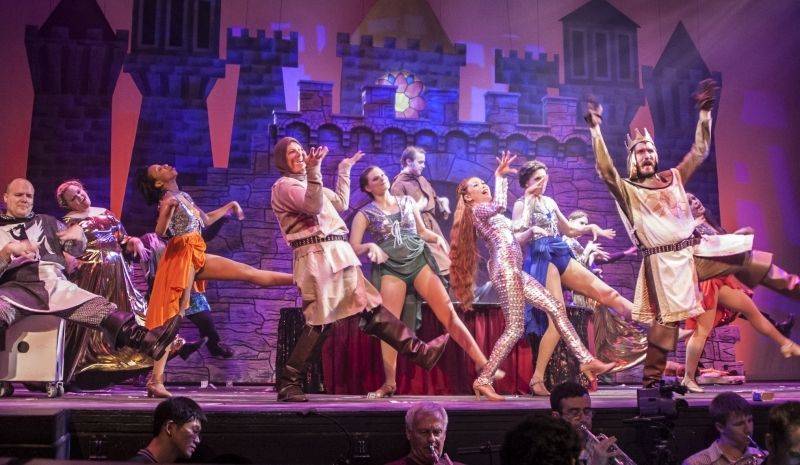
SP: What are the responsibilities of your position at Parkland?
Andrus: I technically have two separate positions. I am the Costume Shop Manager, which means that I oversee our costume stock and the build and wardrobe for each show, manage students performing practicum work in construction and wardrobe management, and generally assist the designer of each show. Which happens this season to have been me in all cases. (I had to figure out how I was meant to assist myself?) In the future I will also likely teach classes. The designer in essence decides what everyone wears when in a production, and in the strictest sense doesn’t typically construct garments. But lines get blurred, especially at smaller theaters.
SP: It occurs to me that, after all this time and so many shows, I still don’t know how you got into designing costumes….
Andrus: I have been sewing since I was really small. My mom taught me. Somehow in my early teens I became obsessed with history and period clothing, particularly the Victorian and Edwardian eras, and discovered that I had a talent for accurately dating clothing and seeing design trends. Then I became a volunteer tour guide at the Molly Brown House Museum in Denver, where everyone works in Edwardian clothing, so I made my own costumes for that. I’ve also been a performer since about the same time I learned to sew, so from time to time I would build my own costumes for a show or help out. But the real beginning of my costume design career was when the producer of Illini Union Board Musicals asked me to design Jekyll and Hyde in 2008, because he knew that the bustle time period was my specialty and didn’t think anyone else could do it. Actually, he had to ask like four times, because I was determined to act in the show (a dream of mine since adolescence). Long story show, I sang the female lead AND designed the costumes, which was one of the most fulfilling, stressful, crazy, and wonderful things I’ve ever done. The rest is kind of history; the high that comes from seeing your designs fulfilled and from creating character through costume pretty much became an addiction.
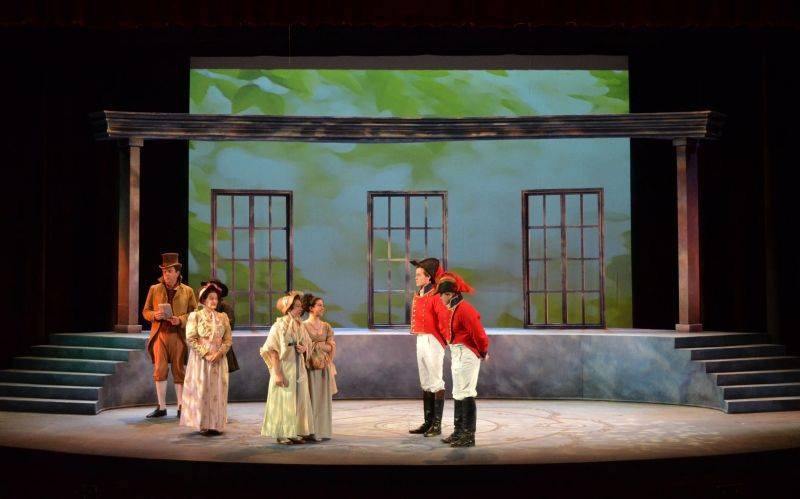
SP: Which show this season was the most difficult to work on, and why?
Andrus: This is a tough question. All of the shows had their challenges. Spamalot was the largest number of distinct costume looks and pieces I’ve ever wrangled. But in the end, I think Pride and Predjudice (pictured above) was the hardest. The Regency period is one that is not frequently performed and is very distinct design-wise, so finding pieces to rent or borrow was challenging. I (and a whole cadre of friend and student recruits) ended up building a lot of costumes. In addition, tailoring men’s garments is pretty complex. For example, we built three entire British Army uniforms in the style of about 1815. In wool. With reversible double-breasted lapels and a ton of gold braid. The summary–a LOT of construction work went into that show.
SP: Speaking of costumes… I have to ask: what was the inspiration for Cara Maurizi’s green dress in Wait Until Dark? It was striking and memorable (hence my bringing it up here). What made you choose that one? What is that thought/creative process? (I’m looking to geek out here.)
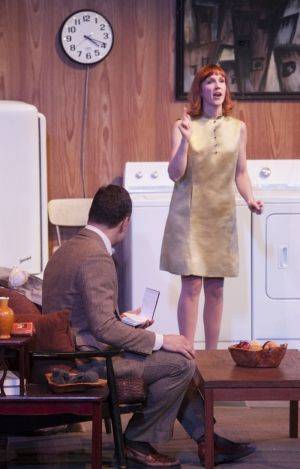 Andrus: I’m really glad you liked that piece! It consumed a fair bit of time in the end. So I wanted Cara (pictured, left) to be visible in low light (but obviously not during full blackout) and was therefore looking for a bright-ish color. I also wanted her character to be stylish and modern in that mid-1960s mod-ish kind of way. Parkland has a good selection of vintage 1960s, so I pulled about 6 dresses that I thought might be it and just tried them on her to see how she reacted and how she looked. I liked that that particular dress was the right modern silhouette (relatively short and angular), it was really flattering on her, and that Cara really felt like she could move in it (since the role was so physical). But it was originally this pale mint green that would have read as white under the lights. So, playing off Cara’s lovely red hair, the color palette of the mid/late 60s, and my feeling that a brighter shade would help the audience follow her in the show, I chose a light avocado. Chemistry geek alert: to figure out which kind of dye to use on the vintage fabric, I did a few tests by burning and test dyeing some small swatches I cut out of a seam allowance. And then I did a few test mixes of different color proportions. Anyway, the dye process took some attention. After that, the original finish on the dress (which made it crisp) had been removed, so I had to figure out how to get something similar back. I eventually starched the whole thing, and we definitely re-starched and ironed it every night (it got water on it in the show) to make sure the effect wasn’t lost.
Andrus: I’m really glad you liked that piece! It consumed a fair bit of time in the end. So I wanted Cara (pictured, left) to be visible in low light (but obviously not during full blackout) and was therefore looking for a bright-ish color. I also wanted her character to be stylish and modern in that mid-1960s mod-ish kind of way. Parkland has a good selection of vintage 1960s, so I pulled about 6 dresses that I thought might be it and just tried them on her to see how she reacted and how she looked. I liked that that particular dress was the right modern silhouette (relatively short and angular), it was really flattering on her, and that Cara really felt like she could move in it (since the role was so physical). But it was originally this pale mint green that would have read as white under the lights. So, playing off Cara’s lovely red hair, the color palette of the mid/late 60s, and my feeling that a brighter shade would help the audience follow her in the show, I chose a light avocado. Chemistry geek alert: to figure out which kind of dye to use on the vintage fabric, I did a few tests by burning and test dyeing some small swatches I cut out of a seam allowance. And then I did a few test mixes of different color proportions. Anyway, the dye process took some attention. After that, the original finish on the dress (which made it crisp) had been removed, so I had to figure out how to get something similar back. I eventually starched the whole thing, and we definitely re-starched and ironed it every night (it got water on it in the show) to make sure the effect wasn’t lost.
SP: Take me through a typical day for Malia during a production. Wake-up to lights-out.
Andrus: Depends on the day of the week and whether I’m performing or running wardrobe or both. I’ll try to give you a sense of how scattered it can get, even outside of a run. During early November, a Friday into Saturday might consist of me waking up at 7:15, heading to my engineering job at 8:30 and working on data analytics projects and statistics code until about 12:30, eating at my desk, driving up to Parkland and madly stitching and supervising students on the Pride build until I had to go to my Chess rehearsal in the early evening. That was typically done around 10 and then I’d try to maybe do laundry and eat a snack before bed (not usually before midnight), and then I would be up and back at Parkland around 9 on Saturday to supervise build workshops all day with volunteers (since many hands make light work). It was pretty intense. By the time Chess was actually running, I considered it a victory if I fed both myself and my cat every day.
SP: Without divulging anything you can’t divulge yet, what are your plans for the near future? Anything you’re looking forward to or wanting to work on?
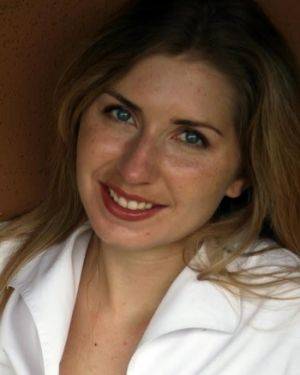 Andrus: This summer I’m going to be managing the costume shop at Sullivan’s Little Theatre on the Square. It’s wonderful and exciting and terrifying all at the same time as it’s an equity house producing EIGHT big shows this summer. To pull that off, I’ll be telecommuting about 10-20 hrs/wk in the early morning for engineering before running the shop all day. I’m also really excited about one of the Parkland shows next season that hasn’t been announced yet, but is squarely in my wheelhouse. To be fair, though, I’m really looking forward to having a vacation if I can in early autumn. I haven’t had more than three consecutive days off since last August…
Andrus: This summer I’m going to be managing the costume shop at Sullivan’s Little Theatre on the Square. It’s wonderful and exciting and terrifying all at the same time as it’s an equity house producing EIGHT big shows this summer. To pull that off, I’ll be telecommuting about 10-20 hrs/wk in the early morning for engineering before running the shop all day. I’m also really excited about one of the Parkland shows next season that hasn’t been announced yet, but is squarely in my wheelhouse. To be fair, though, I’m really looking forward to having a vacation if I can in early autumn. I haven’t had more than three consecutive days off since last August…
SP: You’re one of the theatre community’s most prolific multitaskers. Is it important to you to “do it all?” Or do you see one aspect of your creative life taking the lead?
Andrus: I get different things out of performing and designing. I can’t see that I’ll ever give one or the other up entirely. I take on projects that I think I can tell engaging and enlightening stories with and which challenge me and teach me. Design-wise, I did things this year that improved my tailoring skills, my sense of stylized themes, my organization, and my ability to create intentionally imperfect wardrobes (my inner perfectionist struggled here). In performing, I was lucky to both get the opportunity to be the center of a production and its story in a very consuming way (a dream role), and to conversely be a supportive ensemble member with crazy fun tap and can-can numbers. Design is better paid, though (and by that, I mean paid at all).








